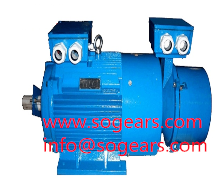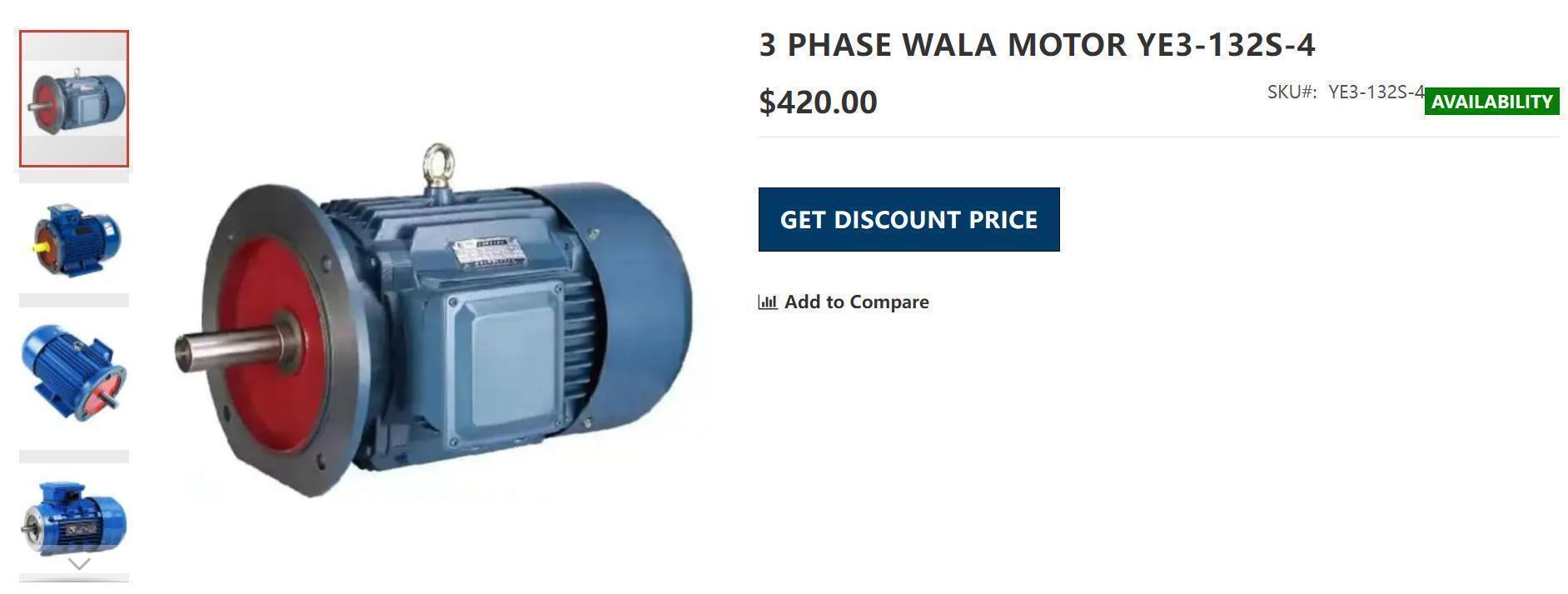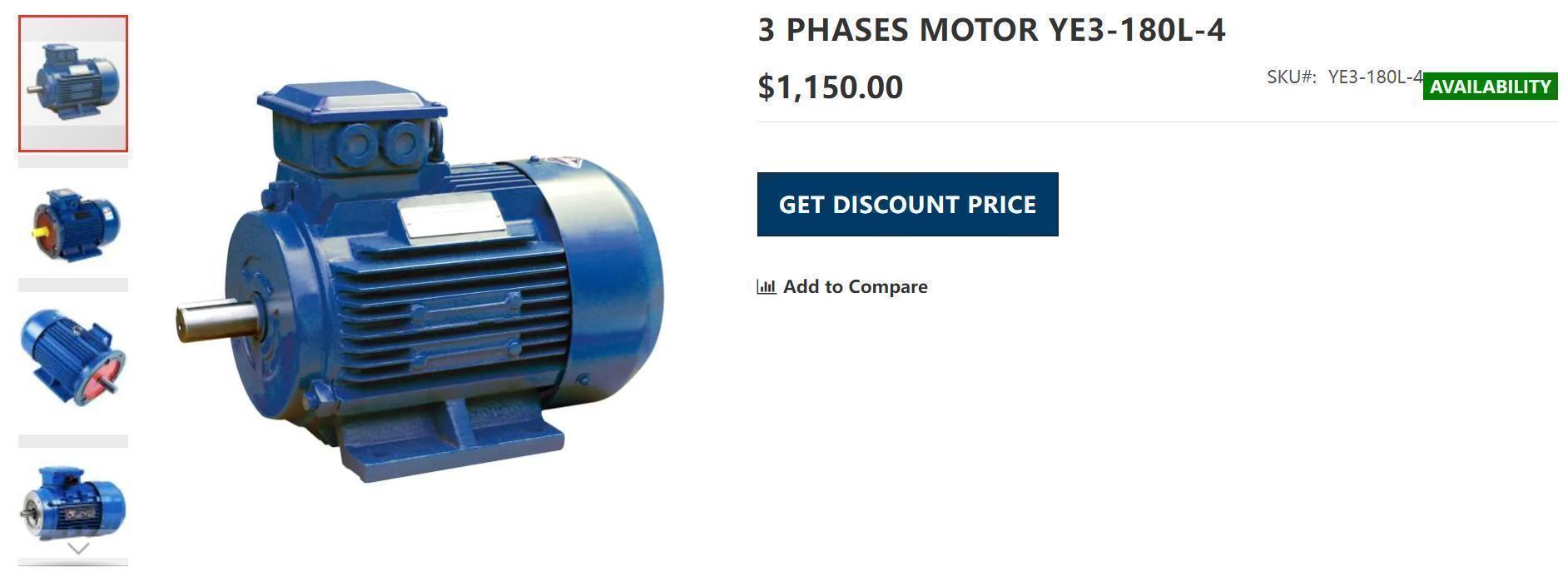Electric motor 1 phase operation of induction motor
Broadly speaking, motor is a conversion device of electric energy, including rotating motor and stationary motor. Rotating motor is an energy conversion device that realizes the mutual conversion between electrical energy and mechanical energy according to the principle of electromagnetic induction; Static motor is an electromagnetic device that realizes voltage change according to the law of electromagnetic induction and the principle of magnetic potential balance, also known as transformer. In this paper, we mainly discuss the rotating motor. There are many kinds of rotating motor, which is widely used in the field of modern industry. It can be said that there will be rotating motor in the occasion of electric energy application. Compared with internal combustion engine and steam engine, the operation efficiency of rotating motor is much higher; Moreover, the transmission of electric energy is more convenient and cheaper than other energy sources. In addition, electric energy also has the characteristics of clean, pollution-free and easy control. Therefore, the application of rotating motor is becoming more and more widely in real life and engineering practice. Different motors have different applications. With the continuous development of motor manufacturing technology and the deepening of the research on the working principle of motors, there are still many new motors, such as the slotless brushless DC motor developed by ead company in the United States, the low-power hybrid stepping motor developed by servo company in Japan, and the large torque low-speed motor developed by China for industrial machine tools and electric bicycles. This paper mainly discusses the types and applications of some motors.
1. Current situation of motor industry
At present, the total installed capacity of motors in China has reached more than 400 million KW, and the annual power consumption has reached 120 billion kwh, accounting for 60% of the total national power consumption and 80% of the industrial power consumption. Among them, the total installed capacity of fans, water pumps and compressors has exceeded 200 million KW, and the annual power consumption has reached 800 billion kwh, accounting for about 40% of the total national power consumption. Therefore, the energy-saving requirements of motors are great and the energy-saving effect can be best reflected. New motor design, new technology and new materials are adopted to improve the output efficiency by reducing the loss of electromagnetic energy, thermal energy and mechanical energy. The efficiency of high-efficiency and energy-saving motor is about 3% - 5% higher than that of traditional motor. At present, the proportion of motor reaching level 2 energy efficiency index is less than 10%, so its development space is broad. With the development and application of power electronics technology, computer technology, microelectronics technology and control theory, the application field of small and medium-sized motors is becoming more and more extensive.
2. Pattern of motor industry
As an important device for electromechanical energy conversion, motor is the basic component of electrical transmission. It has a wide range of applications, a large variety of products and complex specifications. Its product characteristics determine that the industrial concentration is not high, there are many production enterprises and sub industries involved, and there are no obvious periodic, regional and seasonal characteristics. At present, there are more than 2000 domestic differential and small and medium-sized motor manufacturers and supporting manufacturers, which has become an indispensable basic product in the modernization of national economy and national defense. There are many manufacturers in the domestic differential and small and medium-sized motor industry. The market competition is mainly reflected in the technical content, price and production scale of products. Due to the imperfect market mechanism, the price competition in the industry is more intense, which has had an adverse impact on the benign development of the industry. With the enforcement of motor energy efficiency labeling, the manifestation of the role of market survival of the fittest and the further strengthening of industry entry barriers, the impact of price competition will be gradually weakened.
Electric motor 1 phase operation of induction motor
3. Prospect forecast of motor industry
At present, China's electrical machinery accounts for about 21.5% of the global electrical machinery market, which will increase with the recovery of the international economic environment. The domestic market will grow faster than the European and American markets and other countries in the next five-year plan, especially the market of high-efficiency motors. Future trend of motors after 2015, the demand for motors will shift to IE2 Standard Motors, and the market share of ultra-high efficiency IE4 motors is not high. It is predicted that the market share of IE4 type ultra-high efficiency motor will account for 5% in 2015. The recovery of the global economic environment in 2014 has begun to take shape and will be stronger in 2015. With this wind of economic recovery, such as the increase of investment in production and construction industries such as marine construction and ship construction and national infrastructure, the investment in military industry, and the production recovery of various electrical appliance manufacturers, the demand for motors will be 7% - 10% higher than that in 2013. In order to catch up with the "high-speed railway" supported by national policies, enterprises will increase investment in the use and promotion of high-efficiency motors. Compared with 2013, it is expected that the promotion rate of high-efficiency motors that have completed the energy efficiency plan will be more than 95%, and there will be a certain breakthrough in the transformation of motor energy-saving system. The consumption of motor applications in non industrial fields has always been the driving force of the motor industry. The automotive industry is the main buyer of non industrial motors. Light vehicles have more than 30 motors per vehicle on average. The demand for motors in household appliances and residential (heating, ventilation and air conditioning) products, for example, more than 450 million refrigerators and washing machines use motors every year; The disk drive and ventilation fan on each computer will use 3-6 small motors. Compared with the growth of household appliances, Residential HVAC system is expected to drive faster growth of motors. Economic recovery is the general environment, policy is the driving force, and the market is the driving force. In 2015, grasping the industrial direction and combining policy indicators will be a new situation for the motor industry market.
4. Classification and application of motor
As we all know, motor is an important part of transmission and control system. With the development of modern science and technology, the focus of motor in practical application has begun to shift from simple transmission to complex control; Especially for the accurate control of motor speed, position and torque. However, motors have different designs and driving modes according to different applications. At first glance, it seems that the selection is very complex. Therefore, for people, basic classification is carried out according to the purpose of rotating motors. Next, we will gradually introduce the most representative, commonly used and basic motors - control motor, power motor and signal motor.
Electric motor 1 phase operation of induction motor
5. Signal motor
5.1 position signal motor
At present, the most representative position signal motors are resolver, inductosyn and synchro.
Introduction: resolver / transformer is an electromagnetic sensor, also known as synchronous resolver. It is a small AC motor used to measure the angle. It is used to measure the angular displacement and angular velocity of the rotating shaft of the rotating object. It is composed of stator and rotor. As the primary side of the transformer, the stator winding receives the excitation voltage, and the excitation frequency is usually 400, 3000 and 5000Hz. As the secondary side of the transformer, the rotor winding obtains the induced voltage through electromagnetic coupling.
Application status: resolver is a kind of precision angle, position and speed detection device, which is suitable for all resolver resolver resolver occasions where rotary encoder is used, especially in occasions where rotary encoder cannot work normally, such as high temperature, severe cold, humidity, high speed and high vibration. Due to the above characteristics, the resolver can completely replace the photoelectric encoder and is widely used in angle and position detection systems in servo control systems, robot systems, mechanical tools, automobiles, electric power, metallurgy, textiles, printing, aerospace, ships, weapons, electronics, metallurgy, mines, oil fields, water conservancy, chemical industry, light industry, construction and other fields. It can also be used for coordinate transformation, triangulation and angle data transmission. It can also be used in angle digital conversion device as a two-phase phase shifter.
5.2 Inductosyn
Introduction: displacement sensor that converts angular or linear displacement signal into AC voltage, also known as planar resolver. It has two types: disc type and linear type. In the high-precision digital display system or NC closed-loop system, the disk inductosyn is used to detect the angular displacement signal, and the linear inductosyn is used to detect the linear displacement. Inductosyn is widely used in high-precision servo turntable, radar antenna, positioning and tracking of artillery and radio telescope, precision CNC machine tools and high-precision position detection system.
Application status: inductosyn has been widely used in large displacement static and dynamic measurement, such as CMM, program-controlled CNC machine tools, high-precision heavy machine tools and measuring devices of machining centers.
Inductosyn uses the principle of electromagnetic coupling to realize displacement detection, which has obvious advantages: high reliability, strong anti-interference ability, low requirements for working environment, can work normally without constant temperature control and poor environment, and is suitable for the harsh environment of industrial site; Grating sensor realizes displacement detection based on photoelectric mechanism. It has high resolution, accurate measurement and convenient installation and use. The closed grating sensor is more widely used in length measurement than inductosyn because of its strong adaptability to the working environment, the improvement of the performance price ratio of grating sensor and the reduction of technical complexity.
Electric motor 1 phase operation of induction motor
5.3. Synchro
Introduction: synchro is an induction micro motor that changes the angle into AC voltage or from AC voltage to angle by using the characteristics of self-tuning step. It is used as a displacement sensor to measure the angle in the servo system. The synchro can also be used to realize the long-distance transmission, transformation, reception and indication of angle signals. Two or more motors can automatically maintain the same angle change or synchronous rotation of two or more rotating shafts that are not connected to each other mechanically through the connection of circuits. This performance of the motor is called self-tuning characteristic. In the servo system, the synchro used by the party generating the signal is called the transmitter, and the synchro used by the party receiving the signal is called the receiver. Synchro is widely used in position and azimuth synchronous indication systems such as metallurgy and navigation, and servo systems such as artillery and radar.
Application status: the synchro can also be used to realize the long-distance transmission, transformation, reception and indication of angle signal. Two or more motors can automatically maintain the same angle change or synchronous rotation of two or more rotating shafts that are not connected to each other mechanically through the connection of circuits. This performance of the motor is called self-tuning characteristic. In the servo system, the synchro used by the party generating the signal is called the transmitter, and the synchro used by the party receiving the signal is called the receiver. Synchro is widely used in position and azimuth synchronous indication systems such as metallurgy and navigation, and servo systems such as artillery and radar.
5.4 speed signal motor
The most representative speed signal motor is the tachogenerator, which is essentially an electromechanical magnetic element that converts the speed into an electrical signal, and its output voltage is directly proportional to the speed. In terms of working principle, it belongs to the category of "generator". The tachogenerator is mainly used as damping element, differential element, integral element and tachometer element in the control system. So I won't elaborate too much here.
Electric motor 1 phase operation of induction motor
6. Power motor
6.1 DC motor
Introduction: DC motor is the earliest motor. At the end of the 19th century, it can be roughly divided into two categories: with commutator and without commutator. DC motor has better control characteristics. DC motor is inferior to AC motor in structure, price and maintenance. However, due to the problem of speed regulation control of AC motor has not been well solved, and DC motor has the advantages of good speed regulation performance, easy starting and load starting, DC motor is still widely used, especially after the emergence of thyristor DC power supply.
Application status: in life, there are countless applications of electric products. Fan, razor, etc. DC motors are used in automatic doors, automatic locks and automatic curtains in hotels. DC motors are widely used in aircraft, tanks, radar and other weapons and equipment. DC motor is also widely used in locomotive traction, such as railway locomotive DC traction motor, subway locomotive DC traction motor, locomotive DC auxiliary motor, mining locomotive DC traction motor, marine DC motor, etc. The figure above shows Z4 Series DC motor.
6.2 AC motor
Introduction: asynchronous motor is an AC motor that realizes energy conversion based on the electromagnetic torque generated by the interaction between air gap rotating magnetic field and rotor winding induced current. Asynchronous motors are generally series products with a wide variety of specifications. They are most widely used in all motors and have the largest demand; At present, about 90% of machinery in electric drive uses AC asynchronous motor, so its power consumption accounts for more than half of the total power load.
Asynchronous motor has the advantages of simple structure, convenient manufacture, use and maintenance, reliable operation, low quality and low cost. Moreover, the asynchronous motor has high operation efficiency and good working characteristics. It runs at a constant speed from no-load to full load, which can meet the transmission requirements of most industrial and agricultural production machinery. Asynchronous motors are mainly used to drive most industrial and agricultural production machinery, such as machine tools, water pumps, blowers, compressors, hoisting equipment, mining machinery, light industrial machinery, agricultural and sideline products processing machinery, as well as household appliances and medical devices.
Application status: single phase asynchronous motor and three-phase asynchronous motor are more common in asynchronous motor. Three phase asynchronous motor is the main body of asynchronous motor. Three phase asynchronous motor can be used to drive all kinds of general machinery, such as compressor, water pump, crusher, cutting machine tool, transportation machinery and other mechanical equipment, which are widely used in mines. Mechanics. It is used as prime mover in various industrial and mining enterprises such as metallurgy, petroleum, chemical industry and power station. For motors used to drive blowers, coal mills, rolling mills and hoists, relevant technical data shall be provided when ordering, and a technical agreement shall be signed as the basis for special design of motors to ensure reliable operation of motors.. Single phase asynchronous motors are generally used where three-phase power supply is inconvenient. Most of them are micro and small capacity motors, which are widely used in household appliances, such as electric fans, refrigerators, air conditioners, vacuum cleaners and so on.





































